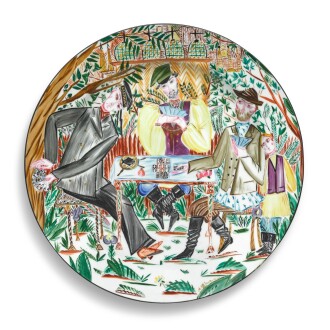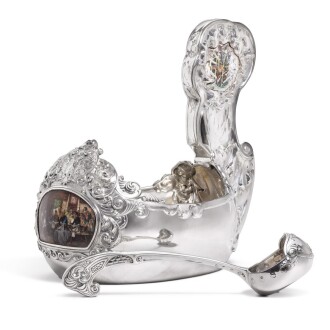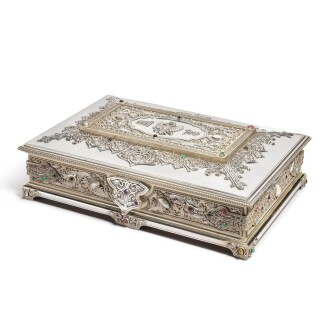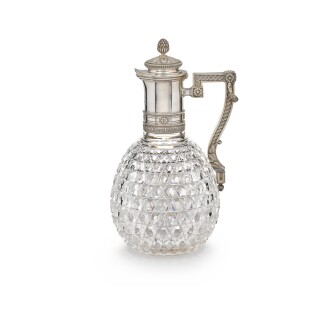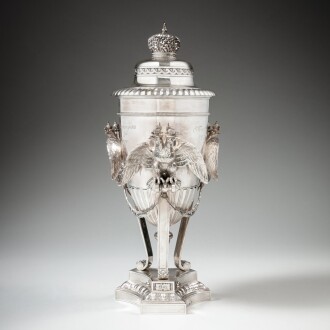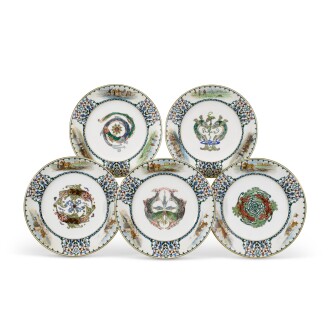S otheby’s Sale of Fabergé, Imperial & Revolutionary Works of Art is led by exceptional enamels and works by Fabergé, including a Rückert casket painted after Makovsky, Imperial presentation pieces, rare icons and museum quality masterpieces in silver on a grand scale. Sourced from private collections across Europe and North America, we are delighted to offer nearly 160 exciting works in enamel, porcelain, bronze and precious metals to the market.
In 2022, Sotheby’s was the only major auction house to hold dedicated sales of Fabergé and Imperial Russian art. This year, with the most experienced specialist team in the field we are delighted to continue offering rare and impressive creations fresh to the market in each of the categories of Fabergé, enamels, silver, icons, bronzes and more.
The sale will be open for bidding from 27 June to 11 July 2023.
Auction Highlights

Leading the sale is a remarkably impressive and important group of enamels and Fabergé silver from an Important American West Coast Collection (lots 44-53). This collection includes an outstanding gem-set Fabergé silver-casket, presented By Emperor Nicholas II to President Loubet on the 1902 French State Visit to Russia, an important imperial presentation silver kovsh with remarkable pictorial en plein enamel panels after Vasnetsov and Kivshenko, and an extremely impressive cloisonné and pictorial en plein enamel casket by Rückert. The collection also includes a set of parcel-gilt figural centrepieces by Ovchinnikov, an imperial presentation enamelled kovsh by Agafonov, as well as further enamels, bronze sculptures and a lacquer box.

Coming from a Distinguished Private French Collection is a wonderful variety of lots in a range of materials, including porcelain - here, two Imperial Porcelain Factory lots (115 and 116), as well as a Sèvres vase as lot 450 in our Paris sale of Classic Design - an important bronze sculpture by the masterful Mark Antokolsky, a painting by Sverchkov and a distinctive work by Aivazovsky which comes to the market for the first time in our Old Master's Day Sale Part I (lots 134 and 133, respectively).

Assembled over four decades, these five distinctive and varied decanters form part of the most significant collection of its kind. Marrying the art of the silversmith and the glassblower these decanters represent the height of this popular decorative art form, which rose to prominence in the 19th century.
From Fabergé Art Nouveau figural mounts, to Neoclassical designs and intricate enamels, this important collection (lots 59, 64, 66, 71 and 78) represents the wide range and impressive skill of Imperial Russia's top silversmiths.

The sale's selection of silverware features examples of outstanding craftsmanship and great historical significance. We are thrilled to offer an exceptional figural casket in Pan-Slavic taste by Khlebnikov (lot 90), three highly important and monumental imperial presentation pieces (lots 99, 43 and 98). Also on offer is a set of silver tea glass holders both in impeccable condition and with their original glass inserts, first purchased by Grand Duchess Xenia Alexandrovna (lot 139), as well as two fine Fabergé decanters in Art Nouveau taste which reflect the firm's superiority with silverwork.

Sotheby’s is delighted to offer lots 136 to 142 without reserve on behalf of Market Street Mission, a New Jersey-based charity supporting the homeless, hungry and those struggling with addiction to get back on their feet. Crafted by Kornilov and retailed by Tiffany & Co., this highly decorative array of porcelain depicts scenes painted after Nikolai Karazin, fantastical fish and representations of birds and trees native to Russia.

The sale's selection of Fabergé exemplifies the firm's expertise in all materials, from finely executed enamelled objets de luxe to beautifully carved hardstones and expertly chased silverware.
A Highlight from Treasures 2023: An Imperial Presentation to a Prussian Prince
A gift from one empire to another, this extraordinarily crafted collar brings history together with impeccable craftsmanship. Formerly in the collections of Prince Friedrich Karl of Prussia and either Prince Alexander or Prince Georg of Prussia, the present collar and badge were presumably presented by Emperor Nicholas II. We are delighted to offer them as lot 43 in our upcoming sale of Treasures.

- Prince Friedrich Karl Nikolaus of Prussia (1828-1885)
Prince Friedrich Karl Nikolaus of Prussia became a Knight of the Order of St Andrew the First Called in 1838 at the young age of ten. His family had close ties to the Romanovs: his mother, Princess Marie of Saxe-Weimar-Eisenach, was the daughter of Grand Duchess Maria Pavlovna, whilst his aunt Princess Charlotte married Emperor Nicholas I, thereby becoming Empress Alexandra Feodorovna. The Prince’s father, Prince Charles of Prussia (Friedrich Carl Alexander, 1801-1883) had himself received each of the Imperial Russian military orders (with the exception of the Order of St Catherine, which was reserved for women). To signify these close familial bonds when in public, it is said that the Hohenzollern and Romanov male family members would simultaneously wear the highest orders of each empire: the Prussian Order of the Black Eagle and the Russian Order of St Andrew.
The present order remained in the possession of Prince Friedrich's family for nearly 100 years when, in 1934, they offered it at auction with Robert Ball in Berlin.

LEFT: THE INNER COVER OF THE 1934 CATALOGUE OF THE SALE OF ORDERS HELD BY ROBERT BALL IN BERLIN; RIGHT: THE CATALOGUE ENTRY FOR THE PRESENT COLLAR IN THE 1934 SALE (LOT 153) - Keibel
Originally founded by Otto-Samuel Keibel (1768-1809), the Keibel workshop later changed hands to those of his son Johann Wilhelm (1788-1862). Johann Wilhelm bolstered his reputation throughout the reign of Alexander I and was eventually invited to rework the Imperial Russian Crown originally created by Posier in preparation for Nicholas I’s coronation. Under the new emperor’s reign, the time in which the present collar was created, Johann Wilhelm’s popularity soared. He was officially heralded as the court goldsmith in March 1841.
- The Imperial Order of the Apostle St Andrew the First Called
The Order of St Andrew, also known as the Imperial Order of the Apostle St Andrew the First Called, was the highest order or decoration in the age of Imperial Russia. Reserved for those who displayed outstanding civilian or military merit, the order was established by Peter the Great in 1698. Peter I was inspired to create the order following a 17-month-long visit to western Europe the previous year during which he encountered the English Most Ancient and Most Noble Order of the Thistle, which shared the same patron saint. Peter saw this order as a means to shift the award system away from gifts of land and money and towards a less expensive method that would also aid in his efforts to Europeanise Russia, which were at the time being met with strong opposition.
As the most significant Imperial Russian order, the Order of St Andrew even inspired dinner services by the Imperial Porcelain Factory. This finely painted service includes a pair of porcelain salt cellars which will be offered in Sotheby's 11th July sale of Fabergé, Imperial & Revolutionary Russian Works of Art.
View Lot - Immanuel Pannasch (1773-1836)
The workmanship of Immanuel Pannasch, the maker of the majority of the present collar, is consistently of outstanding quality. Originally from Saxony, he came to St Petersburg and became a master-enameller and, in 1821, the sole official supplier of Russian Orders. He developed definitive forms of most of the then-existing insignia, and the characteristic brilliance of his enamelwork, particularly in red, has never been surpassed. His St Andrew collars are amongst some of the finest produced. A collar by Pannasch previously sold by Sotheby’s from the Collection of Lily and Edmund J. Safra achieved an astonishing $441,600, over ten times its pre-sale low estimate.
View Lot - Insignia
The Order of St Andrew is the only order which includes a collar chain in its insignia, comprising four different types of links: the main badge, a black enamelled double-headed eagle which is overimposed with the figure of St Andrew bound to the distinctive X-shaped cross (St Andrew declared himself unfit to be crucified on the same type of Latin cross that Jesus had been); another black double-headed eagle holding an orb and sceptre between its talons with a centrepiece emblazoned with an image of St George; a red enamelled gold radiant suns over which is a blue X-shaped cross for St Andrew; and a gold monogram of Peter the Great over a blue enamel ground which sits centrally in the medallion between green and white enamelled gold flags. There was also an additional eight-pointed breast star which was worn with a light blue sash.
Initially, a knight was entitled to ask the treasurer of the order to embellish his insignia with his own precious stones, though this tradition was ended by Paul I in 1797 after these privately embellished insignia were too often confused with officially diamond-covered sets. A knight could also add the insignia of the order to their family coat-of-arms.
View Lot

